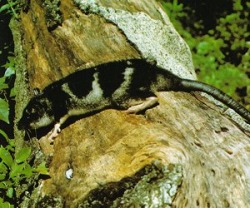Yapok

The Name "Yapok": "Yapok" derives its name from the Oyapock River of South America. It is an aquatic animal. The word "opossum" was taken from the Algonquian Indian word for the animal. Although other animals in South America and Australia are called "possums," they are not closely related to the Virginia animal, and only derive their name by dint of a generally similar shape. True opossums are unique to North America.
Size
27-40cm with a 31-43cm long tail.
Behavior
The yapok can be found from lowland rivers up to mountain streams at least 6000 feet elevation in the eastern Andes. The yapok is the only truly aquatic marsupial. It burrows into stream banks, with an entrance just above water level, and with a nesting chamber dug at the end of a descending tunnel. It may also have a nest of leaves or grass up on the ground for an occasional daytime retreat. An expert swimmer and diver, it eats crustaceans, fish, and other small aquatic animals during the night.
Diet
Crustaceans, fish and amphibians
Water Adaptions

The Water Opossum has several adaptations for its watery lifestyle. It has short, dense fur which is water-repellent. The broad hindfeet are webbed and are used for propulsion through water, moving with alternate strokes. They are symmetrical as well, which distributes force equally along both borders of the webbing; this increases the efficiency of the water opossum's movement through the water. The Yapok's long tail aids its swimming as well.
Being a marsupial and at the same time an aquatic animal, the Water Opossum has evolved a way to protect its young while swimming. A strong ring of muscle makes the pouch (which opens to the rear) watertight, so the young remain dry, even when the mother is totally immersed in water. The male also has a pouch (although not as watertight as the female's), where he places his genitalia before swimming. This is thought to prevent it from becoming tangled in aquatic vegetation and is probably helpful in streamlining the animal as well as it is swimming quickly.
Reproduction
The female's pouch can be closed by a sphincter muscle surrounding its edge, which makes it virtually waterproof for the babies carried inside when the mother is swimming. The female delivers two or three babies at a time, usually in December and January (summertime in South America.)
